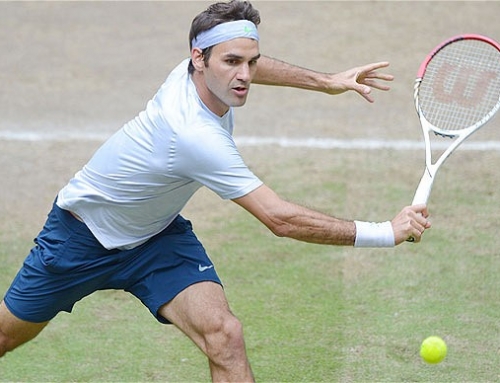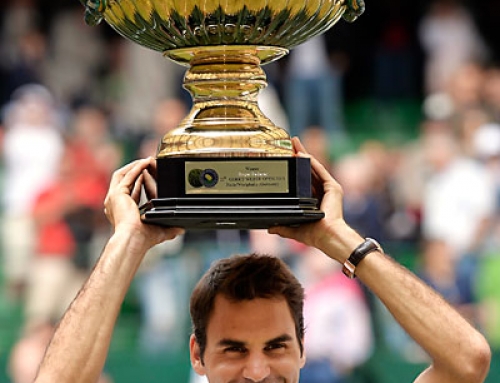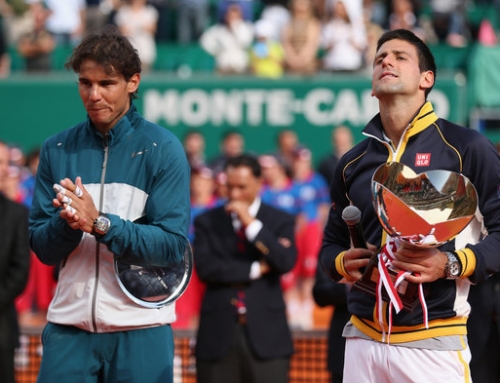 The ATP World Tour Finals is a bit unusual. Almost every tournament is a single-elimination draw with possible bye for the top seeds. The WTF (World Tour Finals) is a round-robin. The event’s name has changed over the years. It started as the Masters Grand Prix or the Masters. For years, it was held at Madison Square Garden in New York City. Because of the weird scheduling of the Australian Open which was pushed to late December in the 1970s (and one reason many players skipped the tournament), the Masters was often held in January.
The ATP World Tour Finals is a bit unusual. Almost every tournament is a single-elimination draw with possible bye for the top seeds. The WTF (World Tour Finals) is a round-robin. The event’s name has changed over the years. It started as the Masters Grand Prix or the Masters. For years, it was held at Madison Square Garden in New York City. Because of the weird scheduling of the Australian Open which was pushed to late December in the 1970s (and one reason many players skipped the tournament), the Masters was often held in January.
For a brief period in the early 1980s, the tournament was a 12-man single elimination tournament with the top 4 seeds getting byes. This was to address a perceived flaw in round-robin play. Due to the round-robin system, some players didn’t care if they won every round-robin match. It was enough to get into the semifinals and try to win the title. Thus, one year, Bjorn Borg had somehow ended second in his group to unheralded Gene Mayer.
There was one round robin match between Jimmy Connors and Ivan Lendl that may have pushed the change. It was the 1980 Masters.
Now, Connors generally got the better of Lendl in the old days. Even so, there was an incentive for Lendl to tank the match. In particular, the winner of this match would play Borg while the loser would play Gene Mayer. Lendl realized he could avoid meeting Borg until the finals if he lost to Connors. Apparently, he tried serving and volleying–something he wasn’t that good at, and lost in straight sets. Lendl would beat Mayer while Connors would lose to Borg (something that happened a fair bit after 1980).
By 1982, the event went to a 12-man single elimination with the top 4 seeds getting byes. The problem with the format? It lead to some uninteresting matches. This format was used int in 1984 and 1984. In 1985, they expanded the tournament to 16 players, which was probably too many. By 1986, they returned back to the 8-man round-robin format and have never looked back.
There was some political issues that created two championships throughout the 1990s. This was resolved in 1999 when they agreed on one championship called the Tennis Masters Cup in 1999. In 2009, the year-end tournament was renamed the ATP World Tour Finals which is its current name.
Let’s quickly cover the format. There are two groups of 4 players each. There’s Group A and Group B. The number 1 seed goes into Group A. The number 2 seed goes into Group B. Then, a coin is flipped for placing 3 and 4 into one of the two groups. The same for 5 and 6, and also for 7 and 8.
This year, the following players are in Group A
- (1) Novak Djokovic
- (3) Andy Murray
- (5) David Ferrer
- (7) Tomas Berdych
The following players are in Group B.
- (2) Rafael Nadal
- (4) Roger Federer
- (6) Jo-Wilfried Tsonga
- (8) Mardy Fish
The round-robin matches begin Sunday, November 20. Group B will play two round-robin matches. On Monday, Group A will play two round-robin matches. The groups alternate each day until Friday when everyone in Group A has played each other and everyone in Group B has played each other.
When that’s done, the two players with the best record from Group A go to the semifinals. The two players with the best records of Group B also go to the semifinals. The best record is determined by wins and losses. If there is a tie, the percentage of sets won is used to break the tie. If there’s still a tie, the percentage of games won is used as a tiebreak. Back in 2009, this third rule was used as a tiebreak as they had to determine whether Juan Martin del Potro or Andy Murray had qualified.
It turned out that del Potro had won by a margin of one game. He won one more game than Murray and thus had the better win percentage.
Regardless of the outcome at London, Djokovic will finish the year at number 1. He has a 4100 point lead over Nadal. Nadal can only win 1500 points at best. Similarly, Nadal has almost 2000 points over Murray. Thus, Nadal will definitely end up as number 2, although Murray can narrow the gap if he does really well.
However, Murray’s lead over Federer is only a little over 700 points. He could, in theory, lose number 3 to Federer, though Federer pretty much has to win at London to make it feasible. Certainly, Federer is the hot player winning Basel and Paris, but Nadal has been training for a few weeks, Djokovic is still seeing if he can play well enough to create problems and Murray was on a hot streak before Paris where he lost to Berdych. It should be noted that Berdych is in Murray’s group.
Because Djokovic’s shoulder is bothering him, it’s hard to tell how he’s going to play. He won’t be highly favored heading in, especially if the injury continues to bother him. Similarly, Nadal didn’t have a great post US Open. Health-wise, he seems fine. However, he did lose to Murray in Tokyo and to Mayer in Shanghai. To be fair, Nadal didn’t perform that much better last year. Nadal did win Tokyo last year, but he came very close to losing to Troicki in the semis. He also lost in Bangkok to Garcia-Lopez and lost to Melzer in Shanghai. Like this year, Nadal chose not to play Paris in 2010, and came back to London and played very well. This suggests that Nadal has time to fix up the problems.
By form, Federer is the hot player heading into London, followed by Murray. Nadal is the unknown and so is Djokovic, but mostly because of injury. This makes London hard to figure out. If Djokovic can play pain-free, he can still surprise and beat any of the top players. Murray talked about the various problems he wanted to work after his Paris loss to Berdych, in particular, his backhand and his serve.
The first two days of London have been set. On Sunday, Federer plays Tsonga as he just did in Paris, and Nadal plays Fish. On Monday, Murray takes on Ferrer while Djokovic takes on Berdych.



![[WTF] Djokovic wins third year-end title with straight set win over Nadal](https://www.essentialtennis.com/wp-content/uploads/2013/11/20131111nole-500x383.jpg)
![[WTF] Djokovic defeats Federer in round robin play](https://www.essentialtennis.com/wp-content/uploads/2013/11/20131105djo-500x383.jpg)


